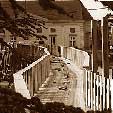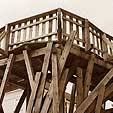
WOOD
FROM VIENNA
By Vincent de Boer
By Vincent de Boer

The next day, I received a fax with the exact measurements totalling 150 cube. I had already been negotiating the costs with two firms for some time, and I would have to come to a decision soon. To have such a huge quantity - four truck loads - transported all the way from Austria seemed at first ridiculous. But as the cost was more than favourable the possibility had be looked into carefully. Furthermore, it was a beautiful thought that the wood from Kawamata's Austrian project would be transformed into a new artwork in Holland. It would make a good story too. To tell the tale, I travelled to Wiener Neustadt to witness the opening of the project.
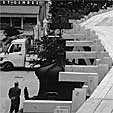
Wiener Neustadt is a small town about 40 kilometres from Vienna. Despite the heavy bombing during the second World War, it still retains its historical aspect. The old town square was to be radically reconstructed and Kawamata had been invited to propose another way of looking at it. Driving my car into the central square, a bridge made of fresh wood stretched across high scaffolding immediatly catches my eye. The first person I see is Kawamata, handling some planks near a flight of stairs under construction. Delighted to see me, we climb the stairs to the walkway together in order to get a good overall view of the huge construction. It is hectic. Assistants coming and going with planks and wood scattered all around.

Later, during lunch in the restaurant downstairs I am introduced to the staff of the Wiener Neustadt Kunsthaus (Art Centre). The Kunsthaus is not, as I expected, a local museum. It consists of two artists in their thirties, who from time to time organize artistic events in the town. I am flabbergasted that this is possible in conservative Austria, where half the population votes for the extreme right or Christian parties. It turns out a progressive lord mayor, who has great ambitions in spite of his small build, is by and large responsible. He plans on making Wiener Neustadt known to the world not only by way of Pink Floyd and Bon Jovi rock concerts but also through Kawamata. It is not surprising he encounters opposition and that the artwork is the talk of the town.
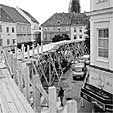
Whilst taking pictures of the wooden walkway that same afternoon I am snarled at, albeit unintelligibly, by an elderly gentleman. The newspapers are keen on a scandal. One of the assistants got slightly hurt and promptly a newspaper's headline read: "The artwork makes its first victim!" The criticism of Kawamata's work is mostly directed towards a waste of money and materials. The newspapers also ask why it should be commissioned to a foreigner.
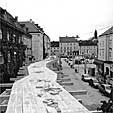
The weather had been bad, time was short and assistence limited. But by now this could not be noticed. The sun was shining and all over the place people were busy finishing the stairs and the handrails. The last of the scattered wood was put into place. At the end of the day the low sun shone beautifully over the as yet abandonded walkway. In the evening Kawamata gave a party for all assistants. They were a motley assembly of wise guys, local artists and jobless immigrants. Some volunteered to come and work in Alkmaar, too. I had no salary to offer, no alcohol or drugs, but I might promise an appealing break from their holiday. The next morning, by the time I arrived at the terrace, Kawamata was having his third interview and his fourth cup of coffee. During my breakfast I informed a number of journalists that the wood would be used again to build a new work by Kawamata. They openly showed signs of relief: the materials were not to be wasted.

Late in the afternoon more and more people were strolling over the walkway. People gathered around the beer booths on the square, too. Some speakers mounted the stage and Kawamata was called to the front. The main sponsor - an insurance company - demonstrated the positive results a merger of risk and art can yield. The lord mayor took the stand. In an almost demagogical way he warned the citizens against politicians who tell them what is good and what is bad about art. "The square is the right arena to decide this, politics isn't," he argued. He met with resounding applause. On the walkway above the local brass band struck up a waltz. The party had begun. It was as if all former criticism had been dumbed. Now was the time to tread the walkway, to drink it in and experience it. The local assistants who made the building, trotted out proudly and where congratulated from all sides. Kawamata's six week intervention gave the central square of Wiener Neustadt a completely different dimension. I looked up to see it one last time. The perspective from which the citizens view the square - or remember it - will probably never be the same.
